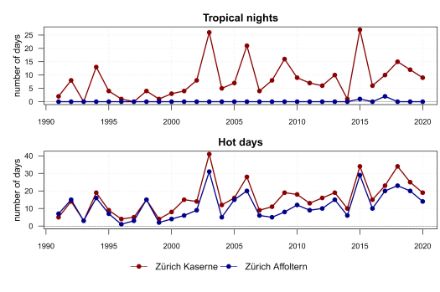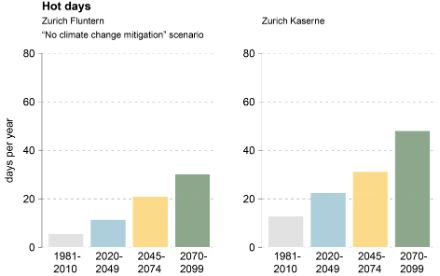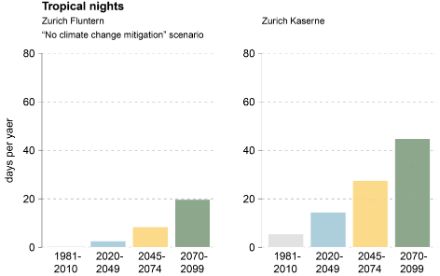Service Navigation
Search
Cities are more densely built up and characterized by a larger fraction of impervious surfaces compared to the more rural surroundings. Moreover, buildings, vehicles and industrial facilities all emit heat into the urban environment. These factors lead to a changed local climate in terms of air temperature, humidity, radiation and wind, as well as air quality and noise pollution.
The urban heat island
The urban heat island effect is one characteristic of a city’s microclimate that can form in any season. The urban-rural temperature difference is especially visible during summer and at nighttime. In Swiss cities, the temperature at night can be up to 5-7°C higher than in the surrounding rural areas. During the day, the temperature difference between urban and rural site is usually smaller, and air temperatures in cities are often only slightly elevated. In terms of temperature-based heat indices, we thus see significantly more tropical nights (days with a minimum temperature of at least 20 °C) in cities than in their rural surroundings, while the number of hot days (days with a maximum temperature of at least 30 °C) is only slightly higher. In street canyons or urban areas without vegetation, however, daytime temperatures can be considerably higher than in the rural surroundings.

These are the main factors responsible for the urban heat island development:
- Building materials store heat very effectively, which means that cities heat up more during the day compared to rural locations, and also cool down much slower.
- Narrow street canyons act as obstacles and reduce wind flow which would bring cooling effects. Vegetation and natural soil in the more rural surrounding have a cooling effect, as they release water vapor into the air and thus act as nature’s air conditioner. Such temperature rebalancing is mostly lacking in cities, where there is a larger fraction of impervious surfaces and a sparser vegetation coverage.
- Man-made pollutant emissions in cities (e.g. from traffic) further reduce the radiation emitted by the surface. Moreover, buildings, vehicles and industrial facilities all emit heat into the urban environment and contribute to the urban heat island.
The urban heat island phenomenon is more pronounced during calm and clear weather conditionswith very little wind and strong solar radiation. This is particularly the case during heat periods.
It is mainly the higher night time temperature, which have a negative impact.The higher nighttime temperatures in urban areas are especially harmful for the human health. The body has little opportunity to recover when nights are not sufficiently cool, which also makes it less able to withstand heat stress during the daytime. Urban planning and architectural measures are needed in order to mitigate or avoid such negative consequences. In addition, it is important to issue timely and effective heat warnings, working in close collaboration with communal/local and cantonal authorities. MeteoSwiss indicates the higher level of heat stress in urban areas in their heat warnings.
Observations in urban areas
In recent years, observational networks have seen significant expansion with urban weather stations . These stations can provide more detailed information on the intensity and the temporal and spatial distribution of urban heat stress. The measurements provide the planning basis for climate-adapted urban development. For example, the data enable planners to specifically target measures that can help reduce the urban heat island effect. The observational networks and weather stations are operated by communal or cantonal authorities, universities and private individuals. MeteoSwiss does not operate weather stations in urban areas, as these locations do not meet international measurement standards (that is, a relatively open and natural environment).
By comparing measurements of a station in an urban area with an adjacent station in a more natural surrounding it is possible to account for the urban heat island effect. A station couple that demonstrates this phenomenon is the rural station Zurich-Affoltern operated by MeteoSwiss and the urban station Zurich-Kaserne operated by the National Air Pollution Monitoring Network (NABEL) of the Federal Office for the Environment (FOEN).
Urban heat stress in the future
Due to the climate change-induced rising temperatures the issue of urban heating becomes ever more pressing. People living in urban areas tend to be more exposed to heat stress and the resulting health risks compared to people living in non-urban areas. In view of the large and growing fraction of people living in urban areas, a strong focus on the unique aspects of present and future urban climate is imperative. This is the only way to develop effective mitigation and adaptation strategies tailored to urban areas.
As part of the Swiss Climate Change Scenarios CH2018, MeteoSwiss analyzed the potential future evolution of different heat indices at various urban stations, namely the number of tropical nights, summer days and hot days. The number of all heat indices is projected to increase until the end of the 21st century, especially if greenhouse gas emissions continually rise (as in the “No climate change mitigation” scenario). Although the average temperatures are increasing at a similar rate in both urban and rural areas, most urban areas will be primarily affected by high temperatures, regardless of the considered period or emission scenario. In the “No climate change mitigation” scenario, for example, the urban population of Zurich would suffer from unprecedented heat stress on numerous days of the year, with almost 50 hot days and 45 tropical nights per year by the end of this century. Results for the adjacent rural station Zurich Fluntern indicate much lower frequencies, with around 30 hot days and 20 tropical nights per year.

